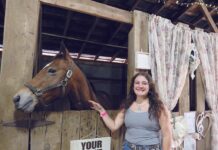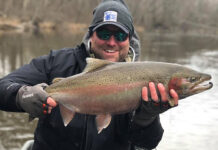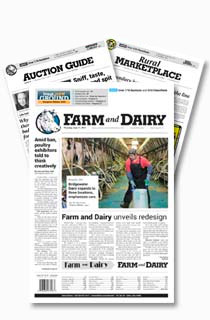As the winter dragged on, he huddled in his home and listened to the cold winds blow across the frozen fields. It was a modest home that was large enough for a bachelor like him. He only recently moved in the fall and as the sunlight peeked into his abode, he looked around and thought all was perfect. And since he was a little jumping spider living in the husk of a swamp milkweed pod, it was perfect.
A few years ago, my wife and I bought an old house across from our home with the grand idea of preserving it and the rich history it possessed. Restoring a house built in 1824 and adding lush gardens around it is the thing that dreams are made of, but not necessarily wallets and bank accounts.
As I mowed the lawn one spring day with the old green lawnmower I inherited from my grandfather, I watched my wife laying out her garden. She turned to look at me as the mower got bogged down by a clump of dirt that a mole so generously erected in the middle of the yard when I heard her scream “STOP!”
I slammed on the brakes of the old tractor and watched my homemade mower hood fly forward testing the physical property limits of my old erector-set-inspired creation, as my wife jumped in front of the mower. She dived down and huddled in front of the mower.
Hastily climbing down off the mower, I saw that she had her hands cupped around a small plant protruding slightly above the blades of grass. “You almost hit it and cut it down,” she scolded me. I was taken aback and thought about explaining the whole point of mowing before wisely reconsidering. As I looked closer, I saw that she had rescued a small swamp milkweed.
Asclepias incarnata, the swamp milkweed, is a perennial plant native to this part of the world; it thrives in the heavy clay soil that abounds here too. Its flowers are less showy, not as fragrant and smaller than common milkweed, but its defining quality is the rose-purple-colored flowers that grace the plant in later summer.
My wife ripped out one of the metal stakes marking the corner of her proposed garden and jammed it in the ground next to the sprite of a plant that most would call a weed and threatened my life in the event I mowed it over. At first, I was less than thrilled to be leaving this little milkweed in the yard especially during its leggy and unattractive “teenage” phase. The neighbors already gave me weird glances and side-eyes followed by a small shake of the head for buying the house. I’m sure this just added fodder to the local gossip.
As the spring turned to summer, I began to see something amazing happen. The plant came to life with activity from a variety of animals and insects.
Swamp milkweeds are like all milkweeds and known to be great host plants and an important source of food for the threatened monarch butterfly population, but reading about it and experiencing it are two extremely different things.
New friends
While mowing one day, I first noticed on top of one of the narrow lance-shaped leaves a tiny black speck about the size of half a grain of rice moving. As I idled the mower next to the plant to further examine this wonderment, it jumped and hid around on the opposite side of the plant’s stalk.
Well, now my curiosity was peaked and I climbed off the mower and jammed by face into the plant and came eye-to-eyes with a tiny jumping spider. I smiled and bid him adieu and for the next two weeks we greeted each other as we performed our routines of modern survival.
The little swamp milkweed kept growing and growing and soon reached the height of five feet and had a width of nearly three. The jumping spider was soon joined by a host of species. Tiny florescent orange aphids sprouted on the stem providing my little spider friend and numerous ladybugs with a snack.
The flowers brought even more life. Honeybees, mason bees, great golden digger wasps, cuckoo bees, swallowtails, Monarch butterflies, red milkweed beetles, hummingbird moths and more all began to frequent the swamp milkweed plant growing in the yard.
Soon, the monarch caterpillars arrived and began to chomp away at the plant, providing spectators an up-close view of the life cycle of the species along with their cute little chubby cheeks.
The visitors to the solitary plant were not exclusive to the insect kingdom, as black-capped chickadees and bluebirds were frequent fliers to the stems of the plant, and a pair of twin fawns took up brief residence beneath the arching crown of the plant. Toads sat beneath its shade while juvenile spring peepers leaped from leaf to leaf.
Life lesson
Soon, I found myself taking daily walks over to the swamp milkweed with a camera in hand to capture the beauty and life of the plant and all its visitors. I didn’t recognize it at the time, but my wife and this dang little milkweed taught me a crucial and unexpected lesson. Sometimes a critical ecosystem rests in the smallest of things, and by making one simple choice or allowance, you can make a huge and profound impact.
Even once all the milkweed pods formed and cracked and released their seed laden “Santa Claus whiskers” to the late fall breezes, the plant was not done providing lessons. As I reluctantly lined the mower up to finally chop down the ol’ milkweed for winter, I felt the need to pay my last respects to this plant that provided so much.
As I surveyed the old, withered leaves and spent pods, I spied a familiar face staring out at me from his little cocoon nestled in the old pod — my dear friend the jumping spider.
As I write this article, I can look out my window and see above the snow the tall milkweed plant that I left standing. I think of my little jumping spider friend and all the amazing sights I saw over the seasons, and I urge you to think about little impacts you can have to help better the ecosystem in your own backyard. Sometimes it’s as simple as leaving one little plant.

















